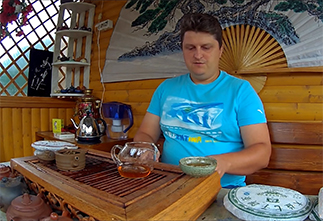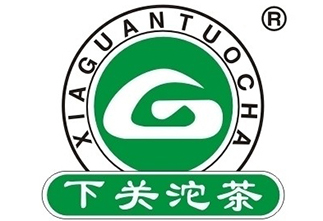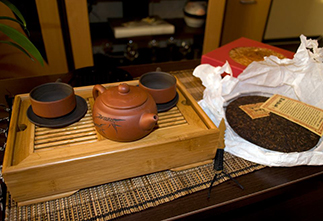"Xia Guan Jia Tuo" (Chinese: 下关甲沱, pinyin: xià guān jiǎ tuó, Russian: "The Best Nest of Xia Guan") is a typical representative of pu-erh tea from the Xiaguan factory (下关沱茶, xiàguān tuóchá) from selected beautiful homogeneous large-leaf Yunnan raw materials (大叶种, dàyèzhǒng, daezhong). Manufactured according to the production standard GB/T22111.
A large 250-gram nest is easily split with a tool. At the beginning of tea drinking, the tea leaf in the aroma gives a sour-sweet smell, reminiscent of a chocolate muffin, over time the aroma passes over a wooden Russian steam bath, as if you are sitting in highly humid hot air. The taste has a distinct bitterness, in which the bitterness of coffee or cocoa is recognized, replaced by a light sweet aftertaste of hematogen and a metallic taste. The color of the tea infusion is brownish-wine-red. When cooling, the tea returns to the chocolate aroma. With a long tea drinking, the bitterness disappears completely and puer softness remains, comparable to Americano of medium strength.
The aroma of dry tea leaves is calm, creamy-woody with nutty notes. After the first steep, sweet confectionery, woody-balsamic, slightly smoky notes (which are typical of Xiaguan Puer) are revealed.
The taste of brewed tea is soft, silky, slightly spicy and smoky, with woody, nutty and creamy nuances. You can read notes of halva, truffle, pastila. Here, confectionery sweetness is skillfully combined with spice and smokiness, giving birth to new shades of taste.
This pu-erh holds even infusions, maintaining its flavor profile, adding only a slight astringency and spice.
The aftertaste is bright and silky with a distinct sweetness.
For brewing, you can use a clay teapot or gaiwan, 8-10 grams of dry tea leaves per 100 ml.
Tea warms you up perfectly, gives you strength, drives away drowsiness and lifts your mood.
Shu puer 2017 "Jiato" from the Xiaguan factory is an excellent factory puer of high quality, with a pleasant distinctive taste and high-quality tea condition.
|
Name in Chinese
|
下关甲沱 |
|
Pinyin
|
xià guān jiǎ tuó |
|
English name
|
“Jiato” of the Xiaguan factory. |
|
Translation
|
The best nest of Xiaguan |
|
Country
|
China |
|
District
|
Dali-Bay Autonomous Region |
|
Provinces
|
Yunnan (云南) |
|
Region
|
Dali Bai Autonomous Prefecture (大理白族自治州) |
|
Manufacturer
|
Сягуань (云南下关沱茶集团) |
|
Raw material production date
|
2017 |
|
Year of pressing
|
2017 |
|
Pressing form
|
Tuo Cha (Tuo Tea) |
|
Declared weight, g
|
250 |
|
Size
|
15x15x7 |
|
Length, cm
|
15 |
|
Width, cm
|
15 |
- Комментарии
- Вконтакте
Pu-erh is one of the most unique types of tea, which only gets better with age. Many people, when they first encounter this tea, wondered: why is pu-erh more often found in pressed form (cakes, bricks, tochas), and not in loose form? The reasons for this are related to both history and the practical aspects of storing and fermenting tea. Despite modern technologies that allow the production of loose pu-erh, the shape of pressed cakes remains unchanged. And pu-erh is more often found on sale in pressed form, for example, in the form of cakes or bricks, and loose pu-erh is less common. We will talk about the reasons for pressing pu-erh into cakes in this article.
Puer is a unique Chinese tea that is distinguished by its depth of taste, complexity of aromas and versatility of aftertaste. Its taste characteristics are formed under the influence of many factors, from growing conditions to the brewing method. Let's look at the main ones.
Сягуаньский чайный завод имеет более чем 70-ти летнюю историю. Он был основан в 1941 году и находится в г. Дали, провинция Юньнань, который часто называют восточной Швейцарией. Прекрасная природа и благоприятная погода, горы и чистейшие озера дают возможность производить пуэр великолепного качества. Сягуаньский чайный завод является одним из главных производителей прессованного чая в Китае. Он производит более 6000 тон чая пуэр ежегодно. Сягуаньский завод производит как Шу пуэр, так и Шен пуэр. Однако наибольшую популярность и признание заслужили Шен пуэры точа (в форме гнезда, чаши) и бинча (в форме блина).
The question often arises: how to brew puerh correctly? Sometimes the phrase "to get high" is added to it. Moreover, everyone has their own understanding of this phrase. Some mean vigor, and some - intoxication. So how to brew puerh tea correctly? Let's consider several options.
Traveling through the tea mountains, we found ourselves in another land of blue roofs - the village of Zhongcai, which is located in the Menghai district of Yunnan province. According to tradition, we were shown another local tea tree, which, according to the Chinese, is at least a million years old :) The village is very authentic, not designed for tourists, there are many wild pu-erhs there and, of course, we were warmly received. They treated us to local cuisine and tea. We also asked the residents about the prices of tea and how they have changed in recent years.
The tea ceremony occupies a special place in the centuries-old Eastern tradition. And although the essence of this phenomenon remains constant, the nature and external manifestations of the tea ceremony in different nations have their own national characteristics. In each Chinese province, the tea ceremony and the tea used in it are varied: for example, residents of the southern provinces prefer green tea, and residents of the northern provinces - red tea, in Fujian province they more often use Oolong tea, and in Yunnan province Puer tea is widely known.



























































































